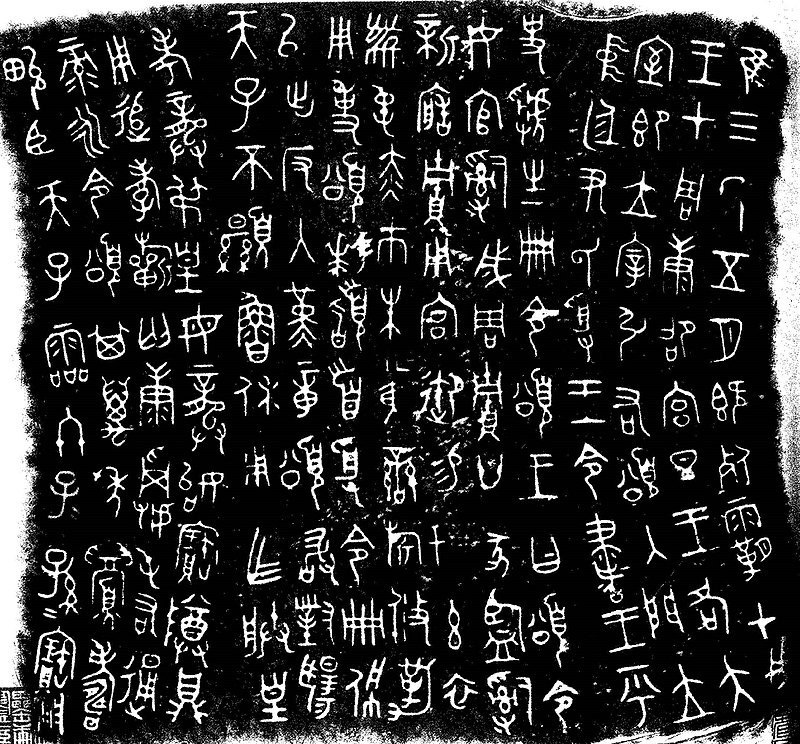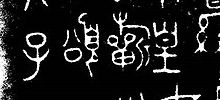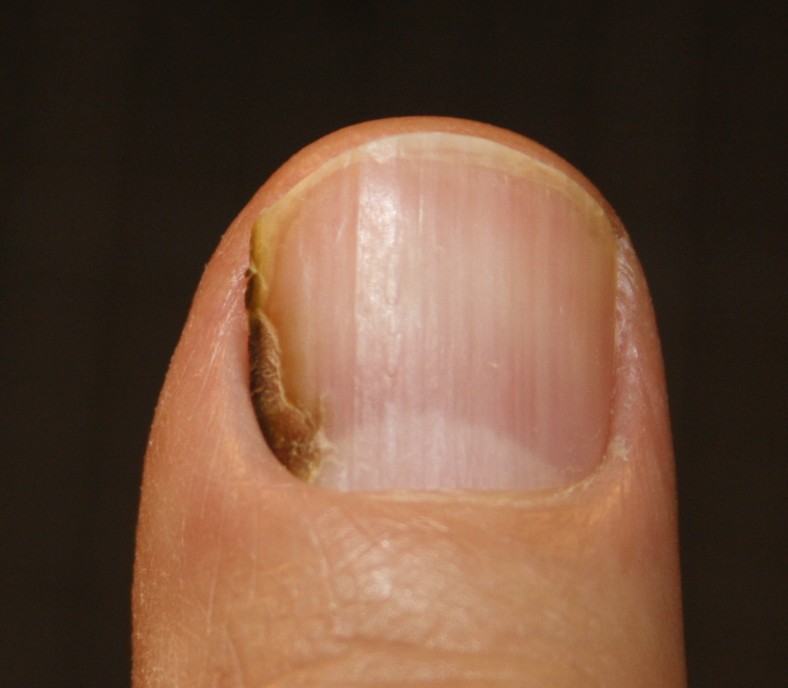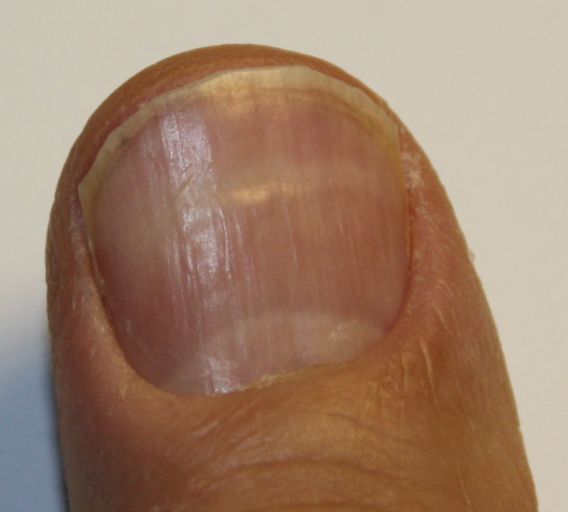

The chinese bronze inscription from 800 BC
John Bjarne Grover
An ancient chinese bronze inscription assumed to be from 800 BC exhibits interesting parallels with photo #2 from my series of photos from the Danube island 2012.
The bronze of 800 BC with 10 lines of ancient chinese script with 15-16 signs in each line exhibits amazing parallels with my photo #2 from the 23 black-and-white photos from the Danube island. (I had no knowledge of the chinese bronze inscription from 800 BC before I wrote the four volumes mentioned at the end of the article - it is only very recently that I have come across it on the internet). In order to enhance and facilitate the comparison of the two documents, I here bring the chinese document along with a slightly abbreviated and stretched version of my photo - on the righthand side there is some dark which does not have a counterpoint in the chinese bronze and the ratios of horizontal and vertical length are not the same - but I have here shortened and stretched my photo (the original is here) for an easy comparison:


It may be that the chinese bronze should have been expanded on the middle for reaching a less concave form for easy comparison with my photo, but I do not have the graphic tools for that.
The isomorphy is recognized in the lower right 'd' on my photo with the exclamation mark under - in the bronze inscription this is seen as a corresponding 'D' plus 'exclamation mark' (the cross) under it:

The same 'D' sign is seen at the end of line 5 on the bronze. (See end of the article for a correlate on this sign from my work).
The photo #2 seems to have two vertical lines of black shadow running approximately where the three main columns are divided on the bronze. The photo seems to show a dentist scene with the dentist dr.Hitcotch (a 'Janus' type) in the mid part, with a client Mrs.Boldog to the right and her husband Mr.Boldog up left - he seems to be somewhat jealous that his wife is in an intimate relation with dr.Hitcotch. (Has he found something 'hid'?) A mafioso type with sunglasses and tight tieknot is hiding in her mouth, could be in the view of Hitcotch, and a wolf is suffering toothache in his throat and is waiting for coming in to the dentist. Dr.Hitcotch seems to be a variant of the leaping lamb in the mid - it is leaping forwards with its two legs with visible patellas down under. A french president or something like that - with scandinavian superego - is running a baby pram, the very leaping lamb, and a cancan dancer seems to be the story of Mrs.Boldog: A foot is up right, the dancer wears a mask and the superego seems to be a czech proletariat novelist (in the upper edge of the photo, over the dancer). These can be called different realities of Gestalt type.
The photo is a map of Europe. Up left is England and one easily finds in the correlate on the bronze (line 4, left third) the Beachy Head with the lighthouse just outside it - the cliff has just fallen out and crossed the channel, it seems on my photo. Here are the chinese bronze signs for this:

The Beachy Head looks somewhat numbstruck next to the lighthouse to the right. To the left - that is the lefthand margin of the bronze - is what would be Swansea or Somerset or Cardiff on the map. This would be the mid point between Klipra in Norway and Fatima in Portugal. The present article observes that those who constructed the assumed political intrigue or program (with Klipra and Somerset) believed that PTRSIM PIK were a genuine expression of what here is the photo-bronze correlation - but the present view is that this is only a surface phenomenon of conspiring or constricting indexes in the role of the cultural or political reaction against the new knowledge. A 'maya' veil of illusion that could be called.
'Cardiff/Harding' (title to TEQ book 4) is seen to the left at Swansea, probably near Cardiff:

From this Cardiff one looks up right to what could be Birmingham with Wolverhampton. Here is the end of PEB 340:
Lenin seen
through Wolverhampton.
which looks like the following fragment from the bronze - for Wolverhampton at Birmingham:

Lenin could be that lower 'smiling lips', with the 'seen through' being the mask on edge. Then 'Wolverhampton' is to the left - sort of F with curled foot - it will be the chinese sign CHU which means 'a step with the right foot' - in contrast to the same sign without a curl at the foot - that is former radical 60 meaning 'a step with the left foot'. Clearly this is the cancan dancer in Valery's poem - the one with the mask in the righthand part of the photo #2. The Wolverham-ton could be the wolf in the waiting room of Dr.Hitcotch's.
This PEB 340 could suggest that the bronze could be from 919-920 BC - if PEB 340 is of sufficient relevance.
The czech proletariat novelist - who is the superego of the cancan dancer - looks in the chinese bronze script like a bell jar for cheeses. Was it he who wrote 'Pronged rake' (fourth last sign on the bronze line 1)? There is an origo cross to the right under him - that looks the same as the 'ear' of the cancan dancer.
The vision mask 'seen through' Wolverhampton at Birmingham can be spotted also as a hanging 'mask' in the part corresponding roughly to Fatima on the european map - here the lower of two in the lefthand margin:

It is the 'mask' that tells of the visionary children of Fatima. Should this mean that the 'Swansea' character is a proof of the reality of PTRSIM PIK? I here lead the argument to the opposite conclusion:
In the lefthand margin of the bronze is seen a series of 10 signs which seem to tell of the 16 titles of The Endmorgan Quartet - here to the left and enumerated in red:

It is 'Cardiff/Harding', the title of book 4, which is the proof: It is a 'Harding' under the 'Cardiff' of #3. This is shown on the map of England, around Swansea. The title of book 3 is 'Cat-Rufus' Earth', the very material substance of Cat-Rufus. Book 2 is called 'The slades with the only turn' - very perfectly on the chinese tablet:

Top left is book 1 - 'Hammerfest' - here as the spectacles of the man-on-wagon and the cross that 'beared' him. One sees the little wagon on 4 wheels.
The interpretation of the rest of the titles of books 1-16 is left to the reader:
1st quarter: The Endmorgan Quartet
1. Hammerfest
2. The slades with the only turn
3. Cat-Rufus' earth
4. Cardiff/Harding
2nd quarter: Birds to Saladin
5. Yes, there is no need for any such attraction
6. Orphan and the angels
7. A sister of Toukhraud
8. Diplomadary and descendature
3rd quarter: A saga Hume
9. ...to be an emperor...
10. A deep ratch
11. Winter Princess
12. Lead lushions in a bowl
4th quarter: Wine 2*
13. Has the next millenium praxis?
14. If you're going to København
15. Gentlemen
16. I tell you, Estunates
Titles 9-12 and 13-16 are not fully represented in the bronze but seem to be captured in line 9 = title 9-12 and line 10 = titles 13-16. The detailed interpretation of these 8 titles seems to be found on the two top lines in the mid section of the bronze:

The upper line is - to the left of the red line - the title of the third part called 'A saga Hume' - the 'saga' of Cardiff and the 'claw' of humans (what separates them from the against apes, according to Ragna Gröver, that is) - with the four titles 9-12 - in the mid upper line. The sign of title 9 looks like the sign YUNG, radical #101 in the 214 system. It means 'to employ, consume, apply, put into practice' - practical as opposed to theoretical. Title 11 resembles the sign CHAN which means 'to behead', 'to cut in two' (Mathews 142). Other CHAN signs resemble title 10 - such as 'to dip into', 'deep, clear' or 'a seam which has come unsewn' = Mathews 144-146. The sign for #12 looks like the australian 'ethnic' instrument of a long tube ending in a brazen echo-bowl, talking the fundamentals of human language. It is the revelational book.
The lower line shows to the left the title to the fourth part called Wine 2* - comprising the four titles 13-16. Chinese for 'wine' = 'guozijiu' resembles this sign - you only have to swap the order of the 'guo' and the 'zi' and interpret the meaning of this. 'Guozi' = 'fruit', hence 'fruit syrup' or 'fruit juice'.
It is the location of title 14 on 'the map of Europe' in photo 2 which is impressive: The 'mouse' is approximately at Copenhagen = København. This is the proof that my book titles are not fished down platonically from chinese students of the bronze plate - since the very 'arbitrary' photo of 2012 is the key to this connection.
Title 15 'Gentlemen' combines perfectly with the lower sign to the right of the second red line - that would have been book 17 if continued:


the elements of which can be recognized in chinese 'gentlemen' in the form 'you limao de ren' = 'you li mao de ren'


The 'L' of the 'li' sign is turned around as a roof for the group, while the 'ren' is lifted and turned 90 degrees in title '17' and the 'de' is a modern partitive (gentle 'of' men - looks french) which is perhaps not really consonant with older conceptions. 'You-li' would mean 'have courtesy/etiquette/manners' ('mao de ren' = 'in appearance of men') and could perhaps suffice for the concept. 'You li' would be the words of the 'french president' with the baby pram while 'mao de ren' would be the answer from the cancan dancer.
It is noticed that the sign to the right in the upper line is also an apparent decomposition of the sign for book 9 - but vertically in contrast to this horizontal decomposition.
The last part of book 16 is called 'Trident and the leak he was - the star'.
Book 16 is the study in parallel with Midori Goto and Robert MacDonald's recording of Bach and Bartok sonatas. My book parts 1-3 - which include part 1-2 for this parallelism - was completed in Athens in the morning and then I later went out in town and into a record shop and found the very fresh record there. The conclusion to the studies of broken and unbroken lines of Bach and Bartok is that the unit of measurement (in the correlation of recorded music and my poetry) is 2 seconds - platonically two 'heartbeats' in 'one mind'. It is well possible that 'Midori Goto' could mean 'meters in mic', but that is just the trapdoor of secret intelligence - this sign from 800 BC tells that it is not a variant of PTRSIM PIK but on the contrary this phenomenon is what the reaction of PTRSIM PIK tries to get under control.
This is also the overall conclusion to this parallelism of the chinese bronze and the photo 2 from the Danube island: My name Grover - in extension also from the 'd' of 'd-vold in the righthand margin of this photo - means not the organized Black Sea Loop reducing the 'groves' of families in houses to 2 and only 2 - but on the contrary it means this photo #2 which correlates with the very beginning of Valery's poem - for the logical order that assigns a semantics to it.
The study tells that PTRSIM PIK is a control mechanism of culture and that the truth lies beyond and independently of this.
The 23 photos were taken very arbitrarily in a shady grove - by the Grover. That is the 'meaning of the name Grover' - not that pulling out to the waiting vans for leaving 2 behind. The 2 is the number of the photo - swapping logical order with 1 in Valery's poem.
Books 9-12 have four or three subtitles in each book. It is interesting to compare these with the verticals under the corresponding titles of the upper line - which means that the first subtitles will correlate with the titles of books 13-16:

Book 9: ...to be an emperor...
Incent treating a filotec course...
Big veitron...
The sting of Egypt
SOLAWBAR...
Book 10: A deep ratch
Piratus
Gay
Please
Book 11: Winter Princess
The chief [...], stolen by amburns
Jordan/Carbon
If okay too travels iconography
Harrison Limbs
Book 12: Lead lushions in a bowl
I wonder
"Sistura". M.Lywork
Pour le ombudsman
In Africa
The proof of the principled independence of my work relative to the chinese bronze is in the 'Copenhagen' sign which looks like a mouse or rat - here it is the 'Pi-rat-us' - but there are only three subtitles so maybe this sign is skipped.
The third subtitle in book 10 looks like the chinese sign CHI (Mathews 5792) which means 'a market, a fair, to trade, an excution ground'.
The first part of book 9 could look like a pre-aged baguette plus a nail scissors futteral - as on 'Finnegans Wake' on the Chu silk manucript:

Book 11 subtitle 3 is the same chinese sign as in the lefthand margin the lowermost sign - for books 13-16 that is. Hence one can postulate an isomorphy of the subtitle
If okay too travels iconography
with
13. Has the next millenium praxis?
14. If you're going to København
15. Gentlemen
16. I tell you, Estunates
There is a certain phonological relevance with 14 and 16 - and maybe a 'practical' similarity with 15. So what about 13?
Book 13-16 contain a large number of subtitles, more than 40 there are, and one can guess that these apply to the rest of the brazen tablet.
Finally, the bronze contains 10 lines of 15-16 signs in each. It seems that these also are the last chapter in my SNEEFT COEIL - this contains 10 poems of 16 lines each and one simply reads it from beginning to end. This chapter is discussed also in my vol.4 as being a little special relative to the 163 event studies I made in Oslo in 1995. It corresponds to TEQ book 5 which here is line 5 which contains the 'Justcan keys' of photo 2 just on line 11 of poem 5 - "in den Schaten-Faden". The lines 10-11 in this poem are #76-77 in the chapter, and indeed that is the number of true-time writing (see vol.4 p.951) of the lines of the Beachy Head phenomenon - it is the following two lines (lines 3 and 4 in poem 4, but written as #76-77 which correspond to lines 10-11 in poem 5):
Der Mond geht wie das goldne Geld
hinter dem Schornstein sich zu holen.
which is that 'face in the moon' going out to the lighthouse.
The line of the 'Wolverhampton' sign (line 2 sign 3 on the bronze) is "weil das ist das letzte Kauen auf Menschen" (poem 2 line 3). The sign of 'Copenhagen' (line 2 sign 8) is "unten am Schäben und unten am Schaal" - two words of oscure meaning but 'Schäbe' means a tool for scratching on a surface - of bronze or tortoise cover or whatever. Line 5 sign 6 resembles somewhat the sign CHI (Mathews 443) = 'to hope', 'to desire' - while poem 5 line 6 is "es ist der wahre Sinn".
The 'D' sign at the end of lines 5 and 8 on the bronze has the following correlates in the last lines of poem 5 and 8 in SNEEFT COEIL: Poem 5 last line = "die Wirklichkeiten der Gestalt". Poem 8 last line = "Ein 'secret agent' ist es nicht".
The phenomenon of the signs on the bronze tablet relative to my own poetry could be the background of the puzzling stripes on my finger nails in 2019:



The black stripe looks like the lefthand margin for the titles of TEQ, the 'washboard' on the ring finger looks like the signs for books 9-16, while the white stripes on all 10 fingers look like the correlation of the 10 lines on the bronze relative to the 10 poems in chapter 8 of my SNEEFT COEIL. These stripes could be the modern counterpoint to the 'skjold' of the 1970's story - and hence be an example of poetic logic that goes beyond the 'political' explanation on the function of names. The 'political' explanation could suggest that the white stripes were due to arsenic poisoning - while poetic logic would find a better explanation.
It can be observed that the article uses information from all the four volumes of my work:
Vol.1 contains the blue metre of 'Wolverhampton' for possible dating 920 BC
Vol.2 contains the 16 books of 'The Endmorgan Quartet' in lefthand margin
Vol.3 contains the 23 black-and-white photos (in 'Poetic semiosis' chapter 18)
Vol.4 contains SNEEFT COEIL chapter 8 and the original order of its lines
It can be guessed that the material in my work in this case can lead to principled opinions on the semiotics of the ancient chinese script signs on the bronze (for example, what was the meaning and sound of the sign second from top in the leftmost margin? - one can study TEQ book 2 for this - that is, if one finds a sensible framework for a reasonably valid logic on such a basis), and then the entire work of four volumes is a part of the study for reaching this. That can be substantial progress for sinology.
Sources
The reproduction of the chinese bronze inscription is from this source.
Manser, M.H.: Concise english-chinese chinese-english dictionary. (Third edition). The Commercial Press / Oxford University Press 2004.
Mathews, R.H.: Chinese-English Dictionary. (A Chinese-English Dictionary Compiled for the China Inland Mission by R.H.Mathews, Shanghai: China Inland Mission and Presbyterian Mission Press, 1931). Revised american edition 1943. Harvard University Press, Cambridge, Massachusetts.
Pocket chinese dictionary - english/chinese chinese/english. (Based on earlier work by Martin H. Manser). Oxford University Press 1999
© John Bjarne Grover
On the web 3 november 2019